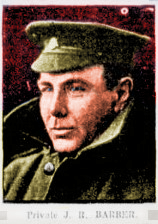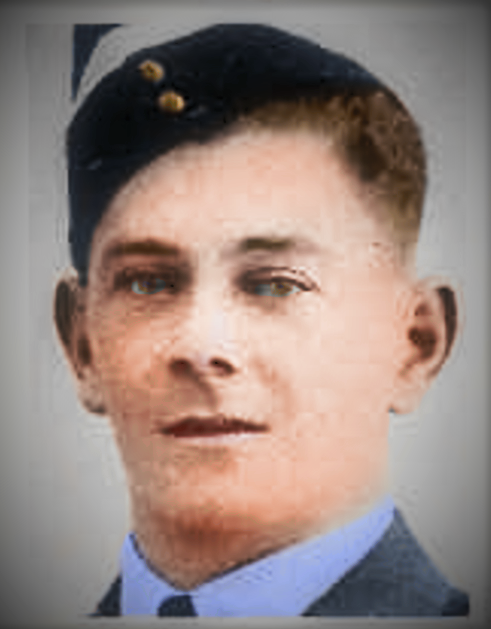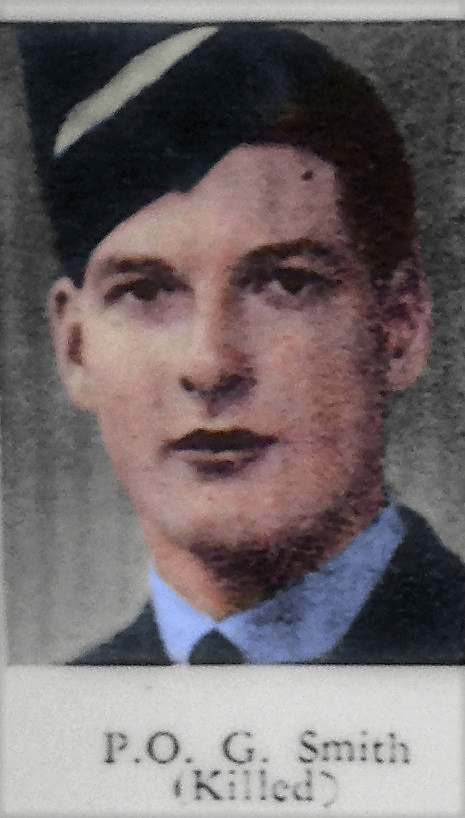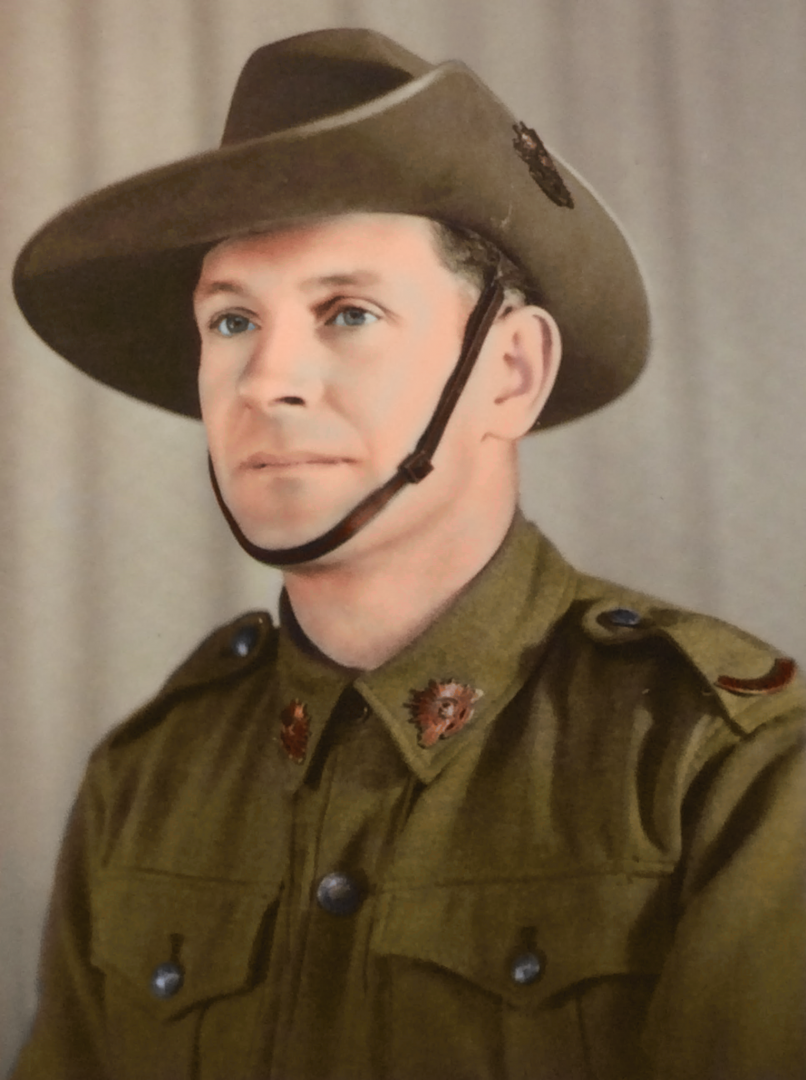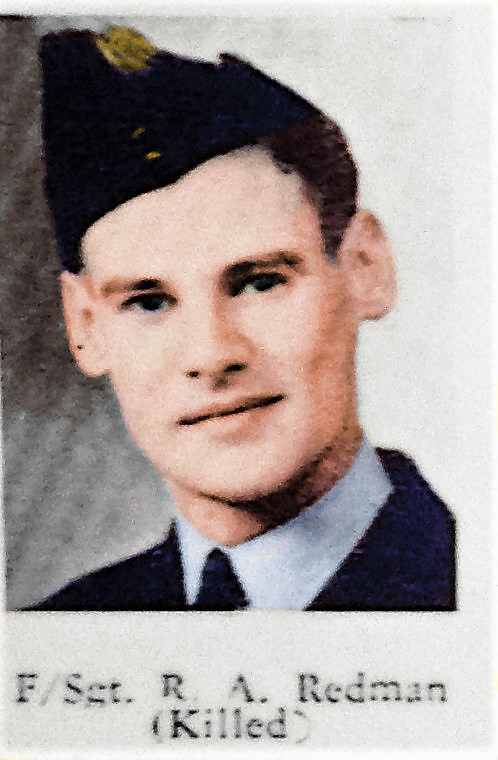Private John Ross BARBER
29 Jul 1876 – 11 Apr 1917
John Ross Barber was born on the 29th of July, 1876, in the town of Goolwa. Barber was the son of William Barber and Elizabeth nee Hennessy, both whom were of British background. The Methodist family later moved to Waikerie. There were a number of children in the family.
William BARBER (Snr) worked for Captain RANDELL on the Murray River opening up the paddle steamer routes. In addition to some Australian born captains, there were a number of Scots who originally worked for Francis Cadell, including William Barber, George Johnston and James Ritchie.
William Snr owned and Captained the Lady Augusta 1862–1866 and the Providence 1866–1868. He also Captained the following paddlesteamers Ruby 1859, Melbourne 1859, Albury 1860, Murray 1862, Gundagai 1862, Queen 1865, Jolly Miller 1866–1869, Culgoa 1872, Vesta 1873, Cumberoona 1873–1875, Lady Daly 1876, Victor 1881 and the Industry 1885–1905.
John had worked for his father on the River then in South Africa for the “South Africa Company Police”. He had then been involved in the Boer War Conflict in South Africa, as part of the “Kitchener’s Horse” cavalry.
By 1906 John BARBER was back in WAIKERIE and working with the irrigation department. In February 1906 when Mr. P. Cowan, who had overseen the Government Channelling work in the settlement moved to Mypolonga. John Barber, was selected to speak on behalf of the drivers and Government men immediately under the control of Mr. Cowan, while expressing regret at Mr. Cowan’s coming departure, he congratulated him upon his promotion. In 1914, John BARBER was still part of the Football Committee for the KIA ORA Football Club and fiercely loyal to his club.
On the 10th of May, 1916, the veteran enlisted as an Australian Imperial Force (A.I.F.) Private. He was aged 39 years and 10 months. His regimental number was 2123.
When Barber joined the Australian Military Forces, he listed that he had worked as a “stable man” and had never married. After enlistment, Barber was reported to the 2nd Depot Battalion for training.
Johns Brother, number 346 Private William BARBER, was serving with the 32nd Battalion and was killed in action with so many other brave men at the battle of Fromelles, in France on the 20 July 1916.
On the 12th of August, 1916, Barber embarked aboard the A70 “Ballarat” at Outer Harbour, South Australia. He disembarked the ship on the 30th of September, 1916, in Plymouth, England for further training. Over a month later, he proceeded to Etaples, France where he was “marched in” to the 48th Battalion A.I.F. and taken on strength. He had an “A” added to his regimental number, making it 2123A.
The 48th Battalion were raised under the command of Lieutenant Colonel Raymond Leane, formerly of the 11th Battalion. Several of Leane’s relatives, including his brother, Benjamin, who served as adjutant, and three of his nephews – Allan, Reuben, and Geoffrey – and a few others, also served in the 48th. As a result the battalion was nicknamed the “Joan of Arc Battalion”, in reference to a quip that the battalion was “made of (all) Leanes” – that is, a pun on Joan of Arc’s own nickname, “The Maid of Orleans.
The 48th were involved in a number of battles until, on April 11, 1917, the battalion was involved in the battle at BULLECOURT in FRANCE.
The Australian attack was to be made east of Bullecourt through barbed wire entanglements and into the trenches of the Hindenburg Line. The wire would be broken by a new weapon, -tanks- rather than the conventional artillery wire-cutting bombardment which usually alerted the enemy to the fact that an attack was imminent. The attack was initially scheduled for dawn on 10 April but the tanks, because of a blizzard, failed to appear.
The historian of the 48th Battalion (South Australia and Western Australia), Chaplain William Devine, was unimpressed:
“The hour came, and the tanks were still waited for, and the minutes passed whilst the men shivered with cold in the snow. All the time they saw grow the daylight which should make their position an exposed and dangerous one. There they lay for an hour and at last the order was given to retire to the trenches … The men got up stiff and cold and cramped, damning the tanks, the stupidity of the higher command that backed the tanks.”
(William Devine, The Story of a Battalion, Melbourne, 1919, p.74)
Next day the attack battalions—the 48th Battalion and the 46th Battalion (Victoria)—reassembled in the snow covered fields. To their right other Australian battalions prepared to advance more directly towards the village of Riencourt-lès-Cagnicourt about two kilometres to the northeast of Bullecourt.
Once again, the tanks failed to appear, and when one finally did so, the Australians had already commenced their advance towards the wire of the Hindenburg Line unaided by anything but their own determination to get through. The wire fortifications were still intact and not severed by bombardments as it was expected the tanks would cut through them for the men.
By 5.30 am the 46th Battalion, despite heavy casualties, had broken through the wire and was in the first line of German trenches known as OG1 and ran on towards Bullecourt. Coming behind the 46th, the 48th fought its way into the next line of trenches – (OG2)— which lay roughly along the banks of the sunken road which leads away to the right of the Australian Memorial Park towards Riencourt-lès-Cagnicourt.
For the next few hours battle raged in this area as the two Australian battalions tried to hold their positions. Because it was believed by higher command that the attack was proceeding well and reaching its final objectives well beyond “OG2” the British artillery failed to fire near these positions.
Consequently the Germans were able to mount strong counter attacks unhindered by shelling. By mid-morning the 46th Battalion had been forced out of its position, many being captured and dozens killed and wounded. Effectively this left the 48th Battalion cut off in OG2 and there was no choice but to fight their way out back to the Australian lines.
Under Captain A.E. Leane, the men of the Australian 48th attacked and captured the trench to their rear. Now artillery from the 5th Army began to fall, but it fell on the Australians. Again, there was no option left but to withdraw. The battle had lasted 10 hours, with shooting ceasing at about 2 pm.
The 4th Brigade took 3,000 men into battle and sustained causalities of 2,339. The 12th Brigade took 2,000 into battle and lost 950. Part of these casualties included 28 officers and 1,142 men captured, by far the most Australian prisoners taken in a single battle during the whole war.
The attack by the Australian 4th Division had actually breeched the Hindenburg line but been left isolated and unsupported by inadequate artillery fire.
It was during all this that John Ross Barber was reported to be missing. Later, he was reported to have been wounded.
The 11th of April 1917 was a terrible day for the 48th Battalion, the official history listing their casualties as 436 killed or wounded.
This Battle injured or claimed the lives of almost 3,500 men. There has been much written about this Battle, and most concur that the action was a debacle; a lesson in how NOT to plan an attack, a senseless waste of men.
John was finally determined at a military inquest in 1918 to have been “Killed In Action on the 11th of April, 1917, in France.”
He was 40 years old. None of his personal belongings were recovered nor was Barber’s body ever found.
He is commemorated on the Villers-Bretonneux Memorial. The memorial is located near the village of Villers-Bretonneux, Picardie, France and is the site of Australia’s main memorial to WW1 in France, the Sir John Monash Centre. The memorial and some of the headstones at the Villiers Bretonneaux cemetery bear bullet scarring from WW2 where Germans soldiers set up an observation and sniper post in the tower and obvious heavy fighting was held to recapture the location.
Barber also has a memorial plaque, no. 340949, in commemoration of him at Headquarters, 4th District Base, Keswick Barracks, Adelaide, South Australia.
John BARBER is not recorded on the WAIKERIE War Memorial or the Waikerie Soldiers Memorial Honour Board. It is believed this may be due to the fact that the BARBER family had moved away from the area prior to the Honour Board being raised in 1928 and prior to the War Memorial being erected later using the information from the Honour Board.
His relationship to Waikerie was only recently discovered and as such he is honoured here and by the local community- BARBER has a rose planted in his honour in the WW1 Memorial garden bed in the Waikerie War Memorial Garden.
In total 13 men are honoured from WW1 this way. An extra rose was planted by the RSL in memory of all those men, women and children who suffered during or after because of the war.
